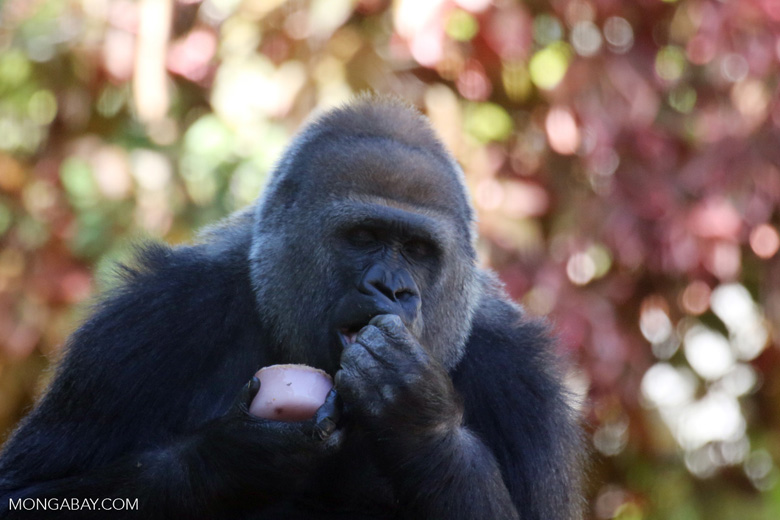A new report by Greenpeace Africa finds this future-plantation has grown by 2,300 hectares in one year between April 2017 and April 2018. In total, Greenpeace estimates around 10,050 hectares have been deforested since clearing began in 2011, and warns that 20,000 more hectares of rainforest are slated for clearing in the coming years.The 45,000-hectare (450-square kilometer) concession is owned by China-owned Sud Cameroun Hévéa (Sudcam), and is located less than one kilometer from Dja Faunal Reserve. The reserve is inhabited by at least 107 mammal species, including critically endangered western lowland forest gorillas. The reserve is also home to the indigenous Baka people.Watchdog and scientific organizations like Greenpeace Africa and the Center for International Forestry Research (CIFOR) warn rubber expansion threatens the integrity of Dja and the future of its wildlife.According to the Greenpeace Africa report, Sudcam’s concession violates a number of
established rules and agreements, including the rubber sourcing policies of several companies that buy from it.
Southern Cameroon is home to some of the most biodiverse areas of African rainforest. It’s also home to a massive area of deforestation destined for rubber cultivation – right across the river from a UNESCO World Heritage Site.
Now, a new report by Greenpeace Africa finds this future-plantation has grown by 2,300 hectares in one year between April 2017 and April 2018. In total, Greenpeace estimates around 10,050 hectares have been deforested since clearing began in 2011, and warns that 20,000 more hectares of rainforest are slated for clearing in the coming years.
The 45,000-hectare (450-square kilometer) concession is owned by China-owned Sud Cameroun Hévéa (Sudcam), and is located less than one kilometer from Dja Faunal Reserve. The reserve is inhabited by at least 107 mammal species, including critically endangered western lowland gorillas (Gorilla gorilla gorilla), endangered chimpanzees (Pan troglodytes) and African forest elephants (Loxodonta cyclotis). The reserve is also home to the indigenous Baka people. Dja was incorporated as a UNESCO World Heritage site in 1987, and the organization notes that it is one of the “largest and best-protected rainforests in Africa,” with around 90 percent of its area intact.

But watchdog and scientific organizations like Greenpeace Africa and the Center for International Forestry Research (CIFOR) warn rubber expansion threatens the integrity of Dja and the future of its wildlife. An earlier report by Greenpeace Africa called its deforestation activity “by far the most devastating new clearing of forest for industrial agriculture in the Congo Basin.” And according to CIFOR, the development “may have serious negative impacts on the [region’s] rich biodiversity … particularly through the destruction of plant cover, increased hunting and poaching, and wildlife disturbance.”
In its newest report, Greenpeace Africa details the clearance of 2,300 additional hectares between April 2017 and April 2018. Effectively increasing the size of the developed area by 22 percent in just one year, this newly cleared area represents a ramp-up in deforestation since clearing began in 2011. This new clearance extends the plantation area further south, as well as east along the border of Dja reserve.
According to the Greenpeace Africa report, Sudcam’s concession violates a number of established rules and agreements. For one, its current proximity to Dja reportedly defies assurance by company management to UNESCO and IUCN inspectors that they would maintain a forest buffer belt of at least five kilometers between the plantation and the reserve.
In June 2017, members of indigenous Baka communities reportedly told Greenpeace Africa researchers that their settlements inside the Sudcam concession had been completely destroyed. According to the report, this forced them “to move without being offered either a resettlement plan or compensation.”
The 45,000-hectare concession was awarded to Sudcam in 2008. However, according to CIFOR research, this appears to have violated Cameroonian law that prohibits development in areas occupied by communities. The researchers write that the award of the concession may have been motivated by an “influential member of the Cameroonian political elite.”
While there is a lack of transparency regarding Sudcam ownership, Greenpeace highlights the proximity of the concession to land owned by Cameroonian president Paul Biya as well as family connections within the company.
“Notably, Sudcam’s plantation lies only seven kilometres from the Mvomeka’a mansion, security compound and airstrip of Cameroon’s head of state Paul Biya, who has held power for over 35 years,” the Greenpeace report states. “A 2016 company document seen by Greenpeace Africa indicates Serge Baroux Mounier, the French brother-in-law of Biya’s son Franck, as a director of Sudcam.”
The Greenpeace Africa report also finds Sudcam’s forest clearance and community displacement process violates the procurement policies of several of the rubber companies that buy from it. These include Bridgestone, Michelin and Goodyear, which require their rubber supply chains be free from deforestation (and land-grabbing, in the case of Goodyear).
Mongabay reached out to Sudcam parent company Halcyon Agri Corporation Ltd., but received no response by press time. In an earlier response to Earthsite and Greenpeace reports released April 27 (but has since been removed), Halcyon Agri denied connection to the government and refuted allegations that it violated land rights of Baka communities.
In an email to Greenpeace Africa referenced in their report, Halcyon Agri CEO Robert Meyer wrote the company is seeking to improve and that “Sudcam is a wonderful asset and one that has the potential to be a working model on how ecological, sociological and economical agendas can be dovetailed into a win-win situation.”
Banner image: Deforestation in the Sudcam concession. Photo by Nchemty Metimi Ozongashu / Greenpeace Africa
Feedback: Use this form to send a message to the editor of this post. If you want to post a public comment, you can do that at the bottom of the page.
Agriculture, Animals, Deforestation, Endangered Species, Environment, Indigenous Communities, Industrial Agriculture, Plantations, Primates, Protected Areas, Rainforests, Rubber, Tropical Forests, UNESCO World Heritage Site, Wildlife
Africa, Cameroon
Source link : https://news.mongabay.com/2018/07/deforestation-for-rubber-ramps-up-near-unesco-site-in-cameroon/
Author :
Publish date : 2018-07-27 07:00:00
Copyright for syndicated content belongs to the linked Source.